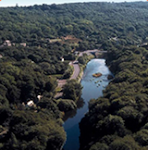Last year saw 10 of us for our first criggy get-together and this year we filled the hall with 40 of us which included a posse from The Friends of The Earth all adding to make a truly atmospheric and enjoyable evening.
After stuffing ourselves silly and drinking ourselves into nearby oblivion (or was that only me?) we had our entertainers take to the stage.
Graham treated us to an excellent poem which took the rise somewhat out of many members of the Wrekin Forest Volunteers and then Margaret & Steve did a similar one and I think we all recognised who they were referring to.
I thought both poems were so good they were worthy of repeating so below is Margaret & Steve’s offering…

The Motley Crew
By Margaret E Mitchell
All hail to our great leader,
He tries his best, but well
To keep control of this motley crew
He hasn’t a hope in hell.
There’s always somebody missing
When it’s time to be back on the bus.
Fossicking, bimbling about
It could be any of us.
It’s most likely the one over yonder,
In his shorts, scrambling round on his knees
Shaking the bushes for insects
With his white sheet under the trees.
Or is it the one up The Wrekin?
Bashing the bracken, fair cruel
With his trusty stick, he slashes about
Like d’Artagnan fighting a duel.
It might be the one who hates ivy
With a passion that’s fiery red.
He cuts through the stems in a frenzy
“Take that!” he screams, “You’re dead!”
There’s one who keeps us all smiling,
He merrily cuts with a swish.
He jokes and laughs while he’s working
Singing, “I know a song about this!”
We’ve got our very own ‘hawk eyes’
No creature too small will she miss
You’ll see her off in the distance
With a ladybird sat on her wrist.
We’ve also got a ‘Town Crier’
Who is usually so gentle and mild,
But when he cries “Oyez-oyez!”
He is suddenly scary and wild.
There’s one who goes missing from time to time,
He likes to wander off piste.
Once he returned, he was waving a bone
Saying “A-Ah! Gnawed by the Ercall Beast.”
The Bicker Twins are joined at the hip,
On descriptions they never agree.
“Look! I can see two spots on the wing,”
“Let me see, that’s not two, that’s three!”
There are some who like insects and moths
Some love spiders the most
Or fungi or rocks or Yorkshire Fog
There’s a lot to keep us engrossed.
Some plod quietly onwards
Others are ever so clever.
We’re intrepid and bold and brave
And turn out whatever the weather.
No task is too hard; we’ll chop anything down
Our code is ‘Never say never’
Are we zany, eccentric and totally mad?
Yes, but hey,
We just have the best Fridays ever.
Thanks Margaret - brilliant poem! Says it all really doesn’t it?! Unfortunately, the pic I took of The Bicker Twins didn’t turn out but hey… you got the most space in this blog post!
Graham was going to send me his poem but he’s sooooo busy at the moment he’s missed the post but hopefully, we’ll get another chance to hear it at some point in the future.
Rob treated us to an expose of life in the North East with an accent so broad it left some of us bewildered (or was that the drink again?). But through the Sunderland mist came many hilarious gems and pearls of wonderful wisdom. Well done Rob!

Penny and Nigel, dressed in traditional WuFuV garb, then gave us a very funny rendition of Henry and Liza’s ‘There’s a Hole In My Bucket’ ending with Nigel’s foot stuck firmly in the bucket!


I left my spot till last, hoping that everyone would forget, but alas they didn’t, so I did a little thing with paper balls and packs of cards called The Malone Mystery, a journey into mind manipulation which surprisingly, and despite several attempts to mug the results, actually worked!

Anyway… it was an excellent night with so much to talk about, so much to eat & drink, with a great time had by one and all. Thanks to everyone who attended to make this a very special party.
.
.
.


























